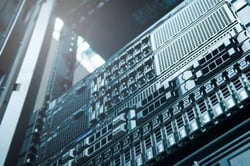What is Digital Transformation?
 The phrase “digital transformation” started to appear in the mainstream media in 2018-2019 and became common in 2020. Yet today, if one asks 20 people for a definition and more importantly, a scoped definition, you’re likely to hear 20 different responses.
The phrase “digital transformation” started to appear in the mainstream media in 2018-2019 and became common in 2020. Yet today, if one asks 20 people for a definition and more importantly, a scoped definition, you’re likely to hear 20 different responses.
With that definition in mind, we have been asked recently what digital transformation means for small and mid-sized manufacturers and distributors. We’ve also been asked, even challenged, to distinguish between Enterprise Resource Planning (ERP) deployment and digital transformation. We’ve been asked if digital transformation is just a newfangled, fancier name for ERP much like Lean Manufacturing became preferred to Just-in-Time Manufacturing sometime around 2000, more about semantics than principles.
Digital transformation can be thought of as more inclusive than ERP, but for most of our clients, the ERP solution is the first or second largest, most expensive, most risk-laden, and highly used component of a company’s digital assets and footprint. The old phrase “necessary but not sufficient” comes to mind when describing ERP’s role in digital footprints. It must be part of the tool kit, and it must be effective, efficient, and well-adopted by company users. A successful ERP system, however, doesn’t complete the digital transformation journey. It’s merely the foundation.
ERP systems have been providing digital, computerized support for core business processes for over 25 years such as:
• Procure-to-pay
• Quote/Order-to-cash
• Plan-to-produce
• Record-to-Report
• Quote/Order-to-cash
• Plan-to-produce
• Record-to-Report
Some companies’ ERP systems go beyond supporting these core business processes, but others require companion or other digital solutions to extend beyond that core. Examples include:
• Lead-to-prospect (pre-sale process often supported by Customer Relationship Management (CRM) software)
• Installation-to-disposal of assets (often supported by Computerized Maintenance Management Systems, or CMMS)
• Concept-to-release (design and engineering processes often supported by Product Lifecycle Management (PLM) software)
• Defect identification-to-resolution (quality management processes often supported by Quality Management Systems and Laboratory Information Management Systems (QMS and LIMS)
• Installation-to-disposal of assets (often supported by Computerized Maintenance Management Systems, or CMMS)
• Concept-to-release (design and engineering processes often supported by Product Lifecycle Management (PLM) software)
• Defect identification-to-resolution (quality management processes often supported by Quality Management Systems and Laboratory Information Management Systems (QMS and LIMS)
The two groups of processes noted above are highly transactional in nature. Data is collected, data is recorded and transformed, and something like a file, document, or another transaction results. There’s a defined beginning and end of each process. These are the processes that Accounting Software originally served and later, ERP software with the integration of MRP software served and supported.
Digital transformation goes beyond these core processes and elements of ERP software. That said, ERP software companies are not content or obliged to adhere to those definitions. ERP software companies continually evolve the definition and scope of ERP, and some have expanded it to include other transactional sets and non-transactional digital elements.
So, what else does digital transformation include that ERP often does not? That will be the subject for a series of upcoming articles. To get the ball rolling, let’s look at one here.
Digital transformation clearly includes the collection of product and process data directly from production equipment. Capturing up and down time and production quantity counts, often known simply as production monitoring, has historically not been in the scope of ERP save for a few examples like SAP and IQMS. Similarly, few ERP solutions offered more advanced process monitoring software that captures process parameters like temperatures, pressures, feeds, speeds, up and down time, and product dimensions. Instead, production and process monitoring software historically has come from independent software companies like Wonderware, Mattec, Tulip, and Machine Metrics.
The costs of production and process monitoring hardware devices has dropped dramatically in the past decade which has, in turn, made capturing data and monitoring machines without human intervention much more affordable. This new industry has become known as the Internet of Things (IoT), and IoT has quickly become an essential component of a manufacturer’s digital transformation journey.
Today, a small minority of clients use IoT technology, but we expect that to become a majority by the end of the 2020s.
In future articles, I will discuss other essential elements and components of a digital transformation journey. Contact us with questions.
Scott Holter is the Director of Meaden & Moore’s Business Solutions Group. He has spent 20 plus years in manufacturing and technology consulting.







